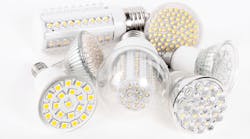Ted Konnerth
Ted Konnerth, Ph.D., is the CEO and president of Egret Consulting, Mundelein, Ill., the largest executive recruiter in the electrical industry. He writes and speaks regularly on the impact of LED lighting technology in the industry, and contributes to such publications as Electrical Wholesaling, tED, and LEDs Magazine.
Konnerth will be one of the speakers at the upcoming IoT Emerge conference in Chicago. He recently sat down with Electronic Design to discuss his views on the integration of the Internet of Things (IoT) into lighting equipment, as well as its impact on the electrical industry.
MG: What is the IoT, from your perspective?
TK: IoT is a nascent industry that has been compared to the emergence of the Internet. The expanse and reach for IoT is unlimited. As a pure empiricist, I see the IoT as a revolution throughout the electrical and electronic industries for a race to grab market share in a market that feasibly has no determined size. IoT is the collection and aggregation of data from trillions of sensors. (I believe the installed sensor size is estimated to hit 1T by 2020, and continue exponentially for decades)
So IoT is the intersection of tech and construction electrical hardware, enabling Big Data.
MG: What are the advantages of LED technology for IoT?
TK: LED is functionally a semiconductor-based system. LED equipment is designed to accommodate electronics: thermal, power supply, control systems, etc. The biggest advantage for IoT adoption is that lighting is everywhere, geographically, so to incorporate sensors into the LED equipment design is relatively “easy.” As such, LED is a carrier for IoT, which satisfies architectural designs and can accommodate sensors for alternative building systems: security, HVAC, building automation, asset management, etc.
Additionally, LED systems can be equipped with Bluetooth capability to transmit that sensor data, or generate Li-Fi systems to provide communication systems. LED technology is low voltage, which provides for the ability to install [new construction] simply, efficiently, and safely.
MG: How will smart lighting and the IoT impact the electrical market?
TK: Smart lighting is a blue ocean market for the lighting industry. Many of the applications for smart lighting have yet to be explored or defined. The earliest adopters have so far delivered an expanded market:
Street lighting has been one of the earlier markets to embrace smart lighting, as municipalities and IOUs (Investor owned utilities) have determined that smart lighting has significant benefits: asset management, maintenance cost reductions, improved safety, power reduction, security applications, and revenue growth. Some IOUs have added features to their muni customers by creating smart parking garages with added security and communication capabilities. In a heavily regulated market such as energy, the ability to create new programs and solutions for their customers adds revenue without significant backlash from their utility commissions.
Indoor sport arenas have provided entertainment value with color mixing and special effects, safety, maintenance benefits and the emergence of creating their own internal Wi-Fi system for crowd control and security.
IOU T&D equipment has been growing in adoption of smart sensors for asset management, predictive maintenance, and power management applications—including sophisticated power routing systems during storm outages.
MG: As an expert in the electrical market, what are some of the challenges for the conversion taking place—from legacy lighting technologies to LED technology in smart buildings and smart outdoor lighting?
TK: LED has been a revolution to the lighting industry that has impacted the entire ecosystem:
Channel partners. The buying influences of LED have expanded with the development of the energy retrofit market and the emergence of hundreds of new companies. The legacy relationships of the past—with extraordinary incentives of rebates, payment terms, preferred customer statuses, indirect sales organizations, and the increased influence of end-user preferences—have roiled the industry.
Margin erosion. Legacy manufacturers had a 100-year history of operating at margins north of 50%. LED has introduced the tech industry market of dropping prices and lowered margins, coupled with increased R&D costs. Balance sheets have been impacted with increased warranty costs, new capital spending, and early write-offs on legacy equipment and processes.
New markets. LED has created markets that never existed: UV treatment, agricultural lighting, human-centric lighting, color-control, etc. Lighting can now be sold as a SaaS revenue, or as an IP licensing or service business.
New entrants. The specifying influence of smart lighting can cross over into other markets: HVAC manufacturers or distributors, security manufacturers or distributors, data/com installers, ESCOs, etc. The downside risk to new entrants is that they don’t have the technical training to design quality lighting applications, so “lighting” can suffer with an expansion of uneducated specifiers entering the field.
Adoption stresses. New markets require talent that understands those markets, or increased training to access those markets. Technological advances require talent that can understand the technology, and communicate and train the buying influences on those applications and advantages. New technology is often difficult to adopt when there are competing presentations and competing explanations of the advantages and disadvantages. New technology, in essence, introduces significant amounts of “noise” into the system.
MG: How do you envision the effect of the IoT in the construction industry?
TK: Technology is an industry that “sells” to relatively smart users. The channel to market for tech is direct to consumer, direct to OEMs for integration into their products, or indirect to electronic distributors (e.g., Future or Arrow), which then sell those components to other OEMs. The construction industry has multiple buying influences, many of which are competitive on the same construction project.
So, lighting has evolved into an elaborate channel structure (I’ve identified over 15 unique lighting channels, each strong enough to support a separate sales channel system). Bringing technology into a construction industry where the end-point is a laborer is a huge challenge. While that can be mitigated by adding specialized commissioning labor into the construction site, it adds complexity. And union labor has a say over which products they install and even potentially where they get installed, so adding a new system will take time and patience.
The other complexity challenge will be educating the specification community on IoT adoption. That community isn’t necessarily involved in the specification of smart systems, so the challenge will be training architects, engineers, and/or lighting designers on how to deploy, specify, bid, install, and commission these systems. Who has province over that will be the subject of a lot of debate—engineers, lighting designers, building automation specialists, or HVAC or data/com specialists?
The construction team of consultants will likely change, and possibly open the door for new entrants who are IoT specialists, which will have to closely communicate with the other specification teams for inclusion of the hardware into which products—lighting, HVAC thermostats, security systems, building automation nodes, etc.
Editor’s Note
IoT Emerge, November 2-4, 2016 at McCormick Place in Chicago, brings to you 35+ IoT expert speakers, over 30 sessions, four keynote addresses, three co-located partner events, two days of sessions, one day of tours, and one exciting expo floor. Enjoy two days of sessions, case studies, workshops, and more Nov. 2 and 3, and one day of tours on Nov 4.
The agenda is now live. View the line-up of incredible speakers.
Take advantage of special discounts for Electronic Design readers only! Register now, using the following discount codes:
- 20% Discount off IoT Emerge Conference or Extreme Passes: IOTE20-DES16
- Complementary Expo Pass: IOTEDESEXPO
Follow @IoTEmerge on Twitter and IoTEmerge on Facebook for the latest speaker, keynote, session, content, and event announcements.
Join the IoT Institute digital community on Twitter or Facebook to stay up-to-date on industry happenings, as well as for articles, featured interviews, and more.


